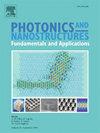Multilayer homogenization and experimental demonstration of artificial plasma matched with free space
IF 2.5
3区 物理与天体物理
Q3 MATERIALS SCIENCE, MULTIDISCIPLINARY
Photonics and Nanostructures-Fundamentals and Applications
Pub Date : 2025-02-01
DOI:10.1016/j.photonics.2024.101344
引用次数: 0
Abstract
A multilayer homogenization technique based on a cascade product of three transfer matrices has been proposed for a general artificial medium comprising periodically stacked impedance sheets. This method has been demonstrated to precisely predict the parameters of structures that mimic artificial plasma with different electrical sizes of the unit cell, while the simple Drude plasma model describes well only structures with a unit cell much smaller than the wavelength. Using the multilayer homogenization technique, we have found some effective permeability that is automatically neglected in the conventional Drude plasma approximation which only considers permittivity. It can seriously affect the desired impedance matching with free space above the plasma frequency. To improve the impedance matching, and thus reduce ripples above the plasma frequency, it is necessary to design unit cells with high equivalent self-inductance. According to theoretical and numerical results, we have demonstrated that the replacement of straight strips with zigzag strips of the same width can considerably improve the quality of the impedance matching. This work opens the route to new designs of high-pass filters based on artificial plasmas with flat transmission above the cutoff frequency. A proof-of-concept experiment is shown.
求助全文
约1分钟内获得全文
求助全文
来源期刊
CiteScore
5.00
自引率
3.70%
发文量
77
审稿时长
62 days
期刊介绍:
This journal establishes a dedicated channel for physicists, material scientists, chemists, engineers and computer scientists who are interested in photonics and nanostructures, and especially in research related to photonic crystals, photonic band gaps and metamaterials. The Journal sheds light on the latest developments in this growing field of science that will see the emergence of faster telecommunications and ultimately computers that use light instead of electrons to connect components.

 求助内容:
求助内容: 应助结果提醒方式:
应助结果提醒方式:


